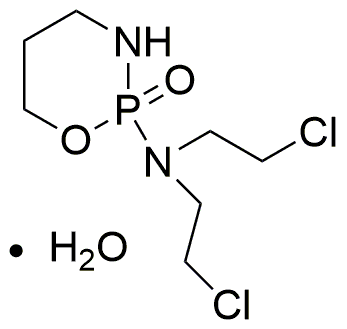Cyclophosphamide monohydrate is widely utilized in research focused on:
- Cancer Treatment: This compound is primarily used as a chemotherapy agent for various types of cancers, including lymphomas and leukemias, helping to inhibit cancer cell growth effectively.
- Immunosuppression: It is employed in organ transplantation and autoimmune disease management to suppress the immune response, reducing the risk of rejection and managing conditions like lupus.
- Pharmaceutical Research: Researchers use cyclophosphamide monohydrate to study drug interactions and mechanisms of action in cancer therapies, providing insights into more effective treatment protocols.
- Veterinary Medicine: This compound is also applied in veterinary oncology, treating tumors in animals, thus improving their quality of life and treatment outcomes.
- Formulation Development: In the pharmaceutical industry, it is used in the development of various drug formulations, benefiting from its solubility and stability characteristics compared to other chemotherapeutic agents.
General Information
Properties
Safety and Regulations
Applications
Cyclophosphamide monohydrate is widely utilized in research focused on:
- Cancer Treatment: This compound is primarily used as a chemotherapy agent for various types of cancers, including lymphomas and leukemias, helping to inhibit cancer cell growth effectively.
- Immunosuppression: It is employed in organ transplantation and autoimmune disease management to suppress the immune response, reducing the risk of rejection and managing conditions like lupus.
- Pharmaceutical Research: Researchers use cyclophosphamide monohydrate to study drug interactions and mechanisms of action in cancer therapies, providing insights into more effective treatment protocols.
- Veterinary Medicine: This compound is also applied in veterinary oncology, treating tumors in animals, thus improving their quality of life and treatment outcomes.
- Formulation Development: In the pharmaceutical industry, it is used in the development of various drug formulations, benefiting from its solubility and stability characteristics compared to other chemotherapeutic agents.
Documents
Safety Data Sheets (SDS)
The SDS provides comprehensive safety information on handling, storage, and disposal of the product.
Product Specification (PS)
The PS provides a comprehensive breakdown of the product’s properties, including chemical composition, physical state, purity, and storage requirements. It also details acceptable quality ranges and the product's intended applications.
Certificates of Analysis (COA)
Search for Certificates of Analysis (COA) by entering the products Lot Number. Lot and Batch Numbers can be found on a product’s label following the words ‘Lot’ or ‘Batch’.
*Catalog Number
*Lot Number
Certificates Of Origin (COO)
This COO confirms the country where the product was manufactured, and also details the materials and components used in it and whether it is derived from natural, synthetic, or other specific sources. This certificate may be required for customs, trade, and regulatory compliance.
*Catalog Number
*Lot Number
Safety Data Sheets (SDS)
The SDS provides comprehensive safety information on handling, storage, and disposal of the product.
DownloadProduct Specification (PS)
The PS provides a comprehensive breakdown of the product’s properties, including chemical composition, physical state, purity, and storage requirements. It also details acceptable quality ranges and the product's intended applications.
DownloadCertificates of Analysis (COA)
Search for Certificates of Analysis (COA) by entering the products Lot Number. Lot and Batch Numbers can be found on a product’s label following the words ‘Lot’ or ‘Batch’.
*Catalog Number
*Lot Number
Certificates Of Origin (COO)
This COO confirms the country where the product was manufactured, and also details the materials and components used in it and whether it is derived from natural, synthetic, or other specific sources. This certificate may be required for customs, trade, and regulatory compliance.


